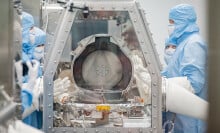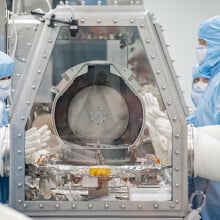Over the past seven years, a NASA spacecraft has put 4.4 billion miles on the odometer as it traveled into deep space to get to Bennu, an asteroid the length of the Empire State Building.
The robot spent years buzzing around the asteroid, hoping it would reveal some of its secrets with an extended observation.
On Sept. 24, scientists take the next big leap forward in learning what Bennu has to offer. The spacecraft, which is now swiftly approaching Earth, will release a capsule holding bits of rock and dirt scooped from the asteroid's surface in 2020. The sample will plunge 63,000 miles through space — one-third the distance from Earth to the moon — pierce Earth's atmosphere, and drop into a Utah desert where a recovery team will whisk it away to a lab.
If all goes well, the OSIRIS-Rex mission, short for Origins, Spectral Interpretation, Resource Identification, and Security Regolith Explorer, will be the United States' first successful asteroid sample returned.
But why Bennu, one might ask? It isn't necessarily a household name. Here are some things we know about the otherwise mysterious asteroid.
How big is asteroid Bennu?
Bennu is a little more than 1,600 feet wide, or about as long as the Empire State Building is tall. For a sense of scale, the world-renowned skyscraper looms more than 100 stories above New York's busy Midtown neighborhood.
The carbon-rich space rock is the shape of a droplet and made of boulders barely held together by their own microgravity. It likely broke off from a larger "parent" asteroid that couldn't hack it as a planet during a collision billions of years ago.
"I like to think of Bennu as a small mountain floating in outer space," said Dante Lauretta, the team's principal scientist, who is based at the University of Arizona.

What does the name 'Bennu' mean?
Bennu, a near-Earth orbiting asteroid, was discovered in 1999. It is named after an ancient Egyptian bird deity. Third-grade student Michael Puzio won a contest to name it in 2013, according to NASA.
But Bennu has earned a nickname among the scientists working on OSIRIS-Rex over the years. They call it "the trickster asteroid" because it has baffled the team every step of the way.
Scientists believed that when the spacecraft touched down to collect the sample three years ago, it would encounter a pebbled surface. Instead, it was greeted by huge boulders. Then, when the spacecraft gently tapped the surface, the asteroid responded sort of like a fluid or plastic ball pit.

When will Bennu hit Earth?
Bennu poses no imminent danger to Earth, and NASA hasn't ever issued a collision warning for this asteroid, or any other. The asteroid has a "close approach" to Earth every six years, though space is a big place. It's about 200 million miles away.
Researchers have estimated Bennu has a 1‐in‐1,750 chance of hitting Earth during one of its close approaches through the year 2300. They have homed in on Sept. 24, 2182, as "the most significant date" in terms of a potential impact, with a probability of 1-in-2,700, or less than 0.04 percent. Still, despite this low risk of a collision, Bennu is considered one of the two most hazardous known asteroids in the solar system, along with another asteroid, 1950 DA.
Want more science and tech news delivered straight to your inbox? Sign up for Mashable's Top Stories newsletter today.
Millions of space rocks orbit the sun. They're the rocky rubble left over from the formation of the solar system about 4.6 billion years ago. Most of that ancient detritus is too far away to pose a threat to this planet. The majority are in the main asteroid belt between Mars and Jupiter, but occasionally rocks get nudged into the inner solar system, relatively closer to Earth.
Scientists are, however, keeping a close watch on 30,000 large objects out there and estimate there could be 15,000 or so more waiting to be discovered. Using powerful telescopes to scan the sky, astronomers are finding about 500 new sizable space rocks in Earth's solar system neighborhood each year.

Why get a sample of Bennu?
Bennu was selected for the mission because it is chock-full of carbon, meaning it could contain the chemical origins of life. Some of the mineral fragments inside the asteroid could be older than the solar system. These same grains of stardust could have come from dying stars or supernovas that eventually led to the formation of the sun and planets.
And despite its minimal chance of hitting Earth in the next century, learning about the asteroid could be helpful in future efforts to deflect it, should that become necessary. Bennu was also considered a convenient asteroid destination because every few years it crosses Earth's orbit around the sun, making it easier to reach than some other asteroids.
Topics NASA



























